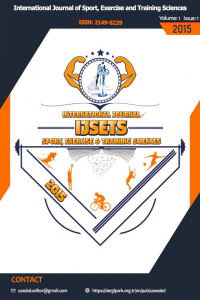Kinetics of cytokines IL-6, IL-10 and TNF-α and their relationship with serum IGF-I and IGFBP-3 concentrations in adolescent swimmers throughout a training season
Kinetics of cytokines IL-6, IL-10 and TNF-α and their relationship with serum IGF-I and IGFBP-3 concentrations in adolescent swimmers throughout a training season
Biomarkers, GH/IGF-I axis, Cytokines, Swimming, Adolescents,
___
- Behnke A.R., Wilmore J.H. (1974). Field Methods, Prentice Hall, New Jersey.
- Boileau R.A., Lohman T.G. (1985). Slaughter M.H. Exercise and body composition in children and youth. Scandinavian J. Sports Sci.; 7:17–27.
- Eliakim A., Cooper D.M., Nemet D. (2014). The GH-IGF-I response to typical field sports practices in adolescent athletes: a summary. Pediatr. Exerc. Sci.; 26 (4): 428-433.
- Eliakim A., Nemet D. (2013). Exercise and the GH/IGF-I axis, in: N. Constantini, A.C. Hackney (Eds.), Endocrinology of Physical Activity and Sport. New York: Springer Science + Business Media; pp. 69–83.
- Eliakim A., Nemet D. (2010). Exercise training, physical fitness and the growth hormone-insulin-like growth factor-1 axis and cytokine balance, in: Jürimäe J., Hills A.P., Jürimäe, T. (Eds.). Cytokines, Growth Mediators and Physical Activity in Children during Puberty. Karger Basel:Med Sport Sci.; pp. 128-140.
- Eliakim A., Nemet D., Bar-Sela S., Higer Y, Falk B. (2002). Changes in circulation IGF-I and their correlation with self-assessment and fitness among elite athletes. Int. J. Sports Med.;23 (8): 600-603.
- Eliakim A., Scheett T.P., Newcomb R., Mohan S., Cooper D.M. (2001). Fitness, training, and the growth hormone - insulin-like growth factor I axis in prepubertal girls, J. Clin. Endocrinol. Metab.; 86 (6): 2797-2802.
- Esteve-Lanao J., Juan A.F.S., Earnest C.P., Foster C., Lucia A. (2005). How do endurance runners actually train? Relationship with competition performance, Med. Sci. Sports Exerc.; 37 (3): 496-504.
- Febbraio M.A., Steensberg A., Keller C., Starkie R.L., Nielsen H.B., Krustrup P., Ott P., Secher N.H., Pedersen B.K. (2003). Glucose ingestion attenuates interleukin-6 release from contracting skeletal muscle in humans. J. Physiol.;549: 607-612.
- Galassetti P., Larson J., Iwanga K., Salsberg S., Eliakim A., Pontello A. (2006). Effect of a high fat meal on the growth hormone response to exercise in children, J. Pediatr. Endocrinol. Metab; 19: 777–786.
- Kapilevich L.V., Kironenko T.A., Zakharova A.N., Kabachkova A.V., Orlov S.N. (2017). Level of interleukins IL-6 and IL-15 in blood plasma of mice after forced swimming test. Bulletin of Experimental Biology and Medicine; 163 (1): 14-17.
- Koziris L.P, Hickson R.C., Chatterton Jr R.T., Groseth R.T., Christie J.M, Goldflies D.G., Unterman T.G. (1999). Serum levels of total and free IGF-I and IGFBP-3 are increased and maintained in long-term training, J. Appl. Physiol.; 86 (4): 1436-1442.
- Maglischo E.W. (2010). Swimming even faster. Barueri: Manole.
- Marchioni D.M.L, Slater B., Fisberg R.M. (2004). Application of the dietary reference intakes in the evaluation of nutrient intake for individuals. Rev. Nutr.; 17 (2): 207-216.
- Martinelli Jr. C.E., Custódio R.J, Oliveira M.H.A. (2008). Physiology of the GH axis-IGF system. Arq. Bras. Endocrinol. Metab.; 52 (5): 717-725.
- Moldoveanu A.I, Shephard R.J., Shek P.N. (2001). The cytokine response to physical activity and training. Sports Med.; 31: 115-44.
- Nemet D., Eliakim A. (2010). Growth hormone-insulin-like growth factor-1 and inflammatory response to a single exercise bout in children and adolescents, in: Jürimäe J., Hills A.P, Jürimäe, T. (Eds.). Cytokines, Growth Mediators and Physical Activity in Children during Puberty. Karger, Basel: Med Sport Sci.; pp. 141-155.
- Nemet D., Oh Y., Kim H.S., Hill M.A., Cooper D.M. (2002). Effect of intense exercise on inflammatory cytokines and growth mediators in adolescent boys. Pediatrics. (4): 681-689.
- Nemet D., Rose-Gottron C.M., Mills P.J., Cooper D.M. (2003). Effect of water polo practice on cytokines, growth mediators, and leukocytes in girls. Med. Sci. Sports Exerc.; 35 (2): 356-363.
- Nindl B.C., Kraemer W.J., Marvs J.O., Arciero P.J., Dohi K., Kellogg M.D., Loomis G.A. (2001). Overnight responses of the circulating IGF-I system after acute heavy-resistance exercise. J. Appl. Physiol.; 90 (4): 1319-1326.
- Petersen A.M., Pedersen B.K. (2005). The anti-inflammatory effect of exercise. J. Appl. Physiol.; 98 (4): 1154-1162.
- Pilz-Burstein R., Ashkenazi Y., Yaakobovitz Y., Cohen Y., Zigel L., Nemet D. Shamash N., Eliakim A. (2010). Hormonal response to taekwondo fighting simulation in elite adolescent athletes. Eur. J. Appl. Physiol.; 1(10): 1283-1290.
- Scheett T.P, Mills P.J., Ziegler M.G., Stoppani J., Cooper D.M. (1999). Effect of Exercise on Cytokines and Growth Mediators in Prepubertal Children. Pediatr. Res.; 46 (4): 429-440.
- Scheett T.P, Nemet D., Stoppani J., Maresh C.M., Newcomb R., Cooper D.M. (2002). The effect of endurance-type exercise training on growth mediators and inflammatory cytokines in pre-pubertal and early pubertal males. Pediatr. Res.; 52 (4): 491-497.
- Seiler K.S., Kjerland G.O. (2006). Quantifying training intensity distribution in elite endurance athletes: is there evidence for an “optimal” distribution? Scand. J. Med. Sci. Sports.; 16: 49-56.
- Silva C.C., Goldberg T.B.L., Teixeira A.S., Marques I. (2004). Does physical exercise potentiate or compromise the longitudinal growth of children and adolescents? Myth or truth? Brazilian Journal of Sports Medicine.; 10 (6): 520-524.
- Tanner J.M. (1962). Growth at Adolescent. Oxford, England: Blackwell Scientific Publications.
- Tourinho Filho H., Pires M., Puggina E.F., Papoti M., Barbieri R., Martinelli Jr C.E. (2017). Serum IGF-I, IGFBP-3 and ALS concentrations and physical performance in young swimmers during a training season. Growth Hormone & IGF Research.; 32: 49-54.
- ISSN: 2149-8229
- Başlangıç: 2015
- Yayıncı: İbrahim ERDEMİR
Gülpınar BAHADIR, İlhan ADİLOĞULLARI
Effect of BMI on Fundamental Motor Skill Proficiency Among 9 to 10 years-old Turkish Children
Fatma İlker KERKEZ, Varol TUTAL
Marcela PİRES, Hugo TOURİNHO FİLHO, Eike Bianchi KOHAMA, Rafael FORNEL, Rodrigo José CUSTODİO, Carlos MARTİNELLİ JR
